- 1Institute of Antibiotics, Huashan Hospital, Fudan University, Shanghai, China
- 2Key Laboratory of Clinical Pharmacology of Antibiotics, Ministry of Health, Shanghai, China
To evaluate in vitro antibacterial activity of MRX-8 against gram-negative bacteria recently isolated from China, 765 clinical isolates were collected randomly from 2017 to 2020, including Enterobacterales and P. aeruginosa and A. baumannii, S. maltophilia, B. cepacia, Alcaligenes app. and Haemophilus spp. isolates. All strains were performed with antimicrobial susceptibility testing by broth microdilution method according to the CLSI 2021. Antimicrobial agents included MRX-8, polymyxin B, colistin, amikacin, ceftriaxone, ceftazidime, cefepime, ceftazidime-avibactam, cefoperazone-sulbactam, meropenem, ciprofloxacin, ampicillin, ampicillin-sulbactam and levofloxacin. For carbapenem-susceptible and carbapenem-resistant E.coli isolates, the MIC50/90 of MRX-8 was 0.125/0.25 mg/L and 0.06/0.125 mg/L, respectively. For carbapenem-susceptible and carbapenem-resistant K. pneumoniae isolates, the MIC50/90 of MRX-8 was 0.25/0.5 mg/L and 0.125/0.5 mg/L, respectively. For polymyxins (polymyxin B and colistin)-resistant E. coli and K. pneumoniae, MIC50 of MRX-8 was 4-16 mg/L and MIC90 was >32 mg/L. The MIC50 and MIC90 of MRX-8 for other Klebsiella spp. except K. pneumoniae, Citrobacter spp., S. enterica and Shigella spp. isolates ranged 0.06-0.125 mg/L and 0.06-0.25mg/L, respectively. For Morganella spp., Proteus spp., Providencia spp., Serratia spp., S. maltophilia and B. cepacia, all MIC50 of MRX-8 was >32mg/L. For carbapenem susceptible and resistant P. aeruginosa, the MIC50 and MIC90 of MRX-8 was both 1mg/L, and that for A. baumannii was 0.5mg/L and 0.5-1mg/L. For Alcaligenes spp. and Haemophilus spp., MIC50/90 was 1/4 mg/L and 0.25/0.5 mg/L. MRX-8 was more effective against most clinically isolated gram-negative isolates, including carbapenem-resistant E. coli, K. pneumoniae, P. aeruginosa and A. baumannii, highlighting its potential as valuable therapeutics.
Introduction
In recent years, antimicrobial resistance has become a serious public health problem. With the rapid dissemination of multidrug-resistant gram-negative bacteria especially for carbapenem-resistant Gram-nagetive bacilli, the selection of antimicrobial agents for treating infections caused by these strains is limited. According to the results from China Antimicrobial Surveillance Network (CHINET) from 2005 to 2020, the drug resistance rates of Klebsiella pneumoniae to imipenem and meropenem were from 3.0% to 23.2% and from 2.9% to 24.2%, respectively. In 2020, the drug resistance rates of Pseudomonas aeruginosa to imipenem and meropenem were 23.2% and 19.3%, respectively; the drug resistance rates of Acinetobacter baumannii to imipenem and meropenem were more than 70% (https://www.chinets.com).
Polymyxin B (PMB) and colistin, called polymyxins, are two of the few drugs available for selection, showing high antibacterial activity against common clinically isolated Gram-negative bacilli. As the CLSI described, colistin and polymyxin B are considered equivalent agents, so MICs obtained from testing colistin predict MICs to polymyxin B and vice versa (Wayne, 2021). Polymyxins were first discovered in the 1940s. It is a group of cyclic peptide antibiotics with A~E components isolated from the Gram-positive spore-forming bacterium Paenibacillus polymyxa (Nang et al., 2021). However, it was soon abandoned in clinical practice due to its high renal toxicity, and has since been mainly used in veterinary drugs and feed additives (Vaara, 2019). With the emergence of carbapenem-resistant Gram-negative bacilli, polymyxins were used in clinical practice as one of the “last line of defense” against multi-resistant gram-negative bacterial infections (Bergen et al., 2012; Brown and Dawson, 2017; Tsuji et al., 2019). MRX-8 is a novel polymyxin analogue in development for the treatment of infections caused by multi-drug resistant Gram-negative pathogens, including E. coli, K. pneumoniae, P. aeruginosa and A. baumannii, and promising in vivo activity was noted for MRX-8 against those pathogens in the mouse thigh and lung model (Lepak et al., 2020). Compared with Polymyxin B, MRX-8 was developed using a “soft drug design,” which represents a new approach aimed at designing safer drugs with an increased therapeutic index by integrating metabolism and detoxification factors into the drug design process (Lepak et al., 2020; Duncan, 2022). Based on the results, apply of MRX-8 in clinical for drug-resistant pathogens in near future are expected and more preclinical evaluation of MRX-8 are needed. In this study, we evaluated the antibacterial activity of MRX-8 and comparators against clinically isolated gram-negative bacteria in China.
Materials and Methods
Bacterial Strains
A total of 765 nonduplicate clinical isolates were collected randomly from 52 hospitals in 20 provinces and cities and 3 autonomous regions including Beijing, Shanghai, Zhejiang, Guangdong and Inner Mongolia from 2017 to 2020, including E. coli (n=122, 18 of polymyxins-resistant strains, 58 of polymyxins-susceptible and carbapenem-susceptible strains, 46 of polymyxins-susceptible and carbapenem-resistant strains), K. pneumoniae (n=138, 32 of polymyxins-resistant strains, 46 of polymyxins-susceptible and carbapenem-susceptible strains, 60 of polymyxins-susceptible and carbapenem-resistant strains), Klebsiella spp.(n=25), Citrobacter spp. (n=25), Morganella spp. (n=25), Proteus spp. (n=25), Serratia Spp. (n=25), Providencia spp. (n=25), Salmonella enterica (n=17), Shigella spp. (n=20), P. aeruginosa (n=100, 46 of carbapenem-susceptible strains and 54 of carbapenem-resistant strains), A. baumannii (n=113, 43 of carbapenem-susceptible strains and 70 of carbapenem-resistant strains), S. maltophilia (n=30), B. cepacia (n=30), Alcaligenes spp. (n=20) and Haemophilus spp.(n=25). Species identification was performed using the matrix-assisted laser desorption ionization–time-of-flight mass spectrometry (Vitek MS; bioMérieux). All strains were mainly isolated from respiratory tract (500/765, 65.4%), blood (38/765, 5.0%), urine (227/765, 29.7%).
Antimicrobial Susceptibility Testing
MICs were determined by the reference broth microdilution method according to the 31st Clinical and Laboratory Standards Institute (CLSI) (Wayne, 2021). MRX-8, polymyxin B, colistin, amikacin, ceftriaxone, ceftazidime, cefepime, ceftazidime-avibactam, cefoperazone-sulbactam, meropenem, ciprofloxacin, ampicillin, ampicillin-sulbactam and levofloxacin were tested using a dried customized commercially prepared microdilution panel (Sensititre; Thermo Fisher Scientific). And MRX-8 was obtained from the MicuRx company. E. coli ATCC 25922, P. aeruginosa ATCC 27853, Haemophilus influenzae ATCC 49766 and Haemophilus influenzae ATCC 49247 were used as the quality control strains in the antimicrobial susceptibility testing. Quality control and interpretation of the results were based on 2021 CLSI breakpoints for all the antimicrobial agents with the exception of polymyxin B and colistin. polymyxin B and colistin MICs were interpreted using the European Committee on Antimicrobial Susceptibility Testing (EUCAST) (Susceptible, MIC ≤ 2 mg/L; Resistant: MIC≥4 mg/L). MRX-8 MICs were interpreted using CLSI breakpoints for polymyxin B or colistin for comparison purpose only.
Carbapenem-Resistant Enterobacterales Definition
As defined by the Centers for Disease Control and Prevention (CDC), the Enterobacterales isolates resistant to at least one of the carbapenems (ertapenem, meropenem, doripenem, or imipenem) or produce a carbapenemase were carbapenem-resistant Enterobacterales (CRE) (https://www.cdc.gov/hai/organisms/cre/technical-info.html#Definition).
Results
In Vitro Activity of MRX-8 Against Clinical Isolates
MRX-8 exhibited potent antibacterial activity against both carbapenem-susceptible and carbapenem-resistant Enterobacterales. For polymyxins (polymyxin B and colistin)-susceptible E. coli, the MIC50 of MRX-8 was 0.125mg/L and 0.06mg/L, and the MIC90 was 0.25mg/L and 0.125mg/L, when against carbapenem-susceptible and carbapenem-resistant strains, respectively. For polymyxins-susceptible K. pneumoniae, carbapenem-susceptible and carbapenem-resistant strains, the MIC50 of MRX-8 was 0.25 mg/L and 0.125 mg/L, respectively, and the MIC90 was both 0.5mg/L. As expected, MRX-8 also showed poor antibacterial activity against polymyxins-resistant E. coli and K. pneumoniae with MIC50 of 4 mg/L and 16 mg/L, respectively, and MIC90 of >32 mg/L (Tables 1, 2). The MIC50 and MIC90 of MRX-8 for other Klebsiella spp., Citrobacter spp., Salmonella enterica and Shigella spp. strains ranged from 0.06 to 0.125 mg/L and 0.06 to 0.25mg/L, respectively. MRX-8 exhibited potent antibacterial activity against both carbapenem-susceptible and carbapenem-resistant P. aeruginosa and A. baumannii. The MIC50 and MIC90 of MRX-8 for P. aeruginosa was both 1mg/L, and that for A. baumannii was 0.5mg/L and 0.5-1mg/L, respectively. MRX-8 showed no antibacterial activity against Morganella spp., Proteus spp., Providencia spp., and Serratia spp., S. maltophilia and B. cepacia with MIC50 of >32 mg/L (Tables 3–5). MRX-8 exhibited potent antibacterial activity for Alcaligenes spp. with MIC50 and MIC90 of 1mg/L and 4mg/L, respectively (Table 6). MRX-8 also exhibited potent antibacterial activity for Haemophilus spp. with MIC50 and MIC90 of 0.25mg/L and 0.5mg/L, respectively (Table 7).
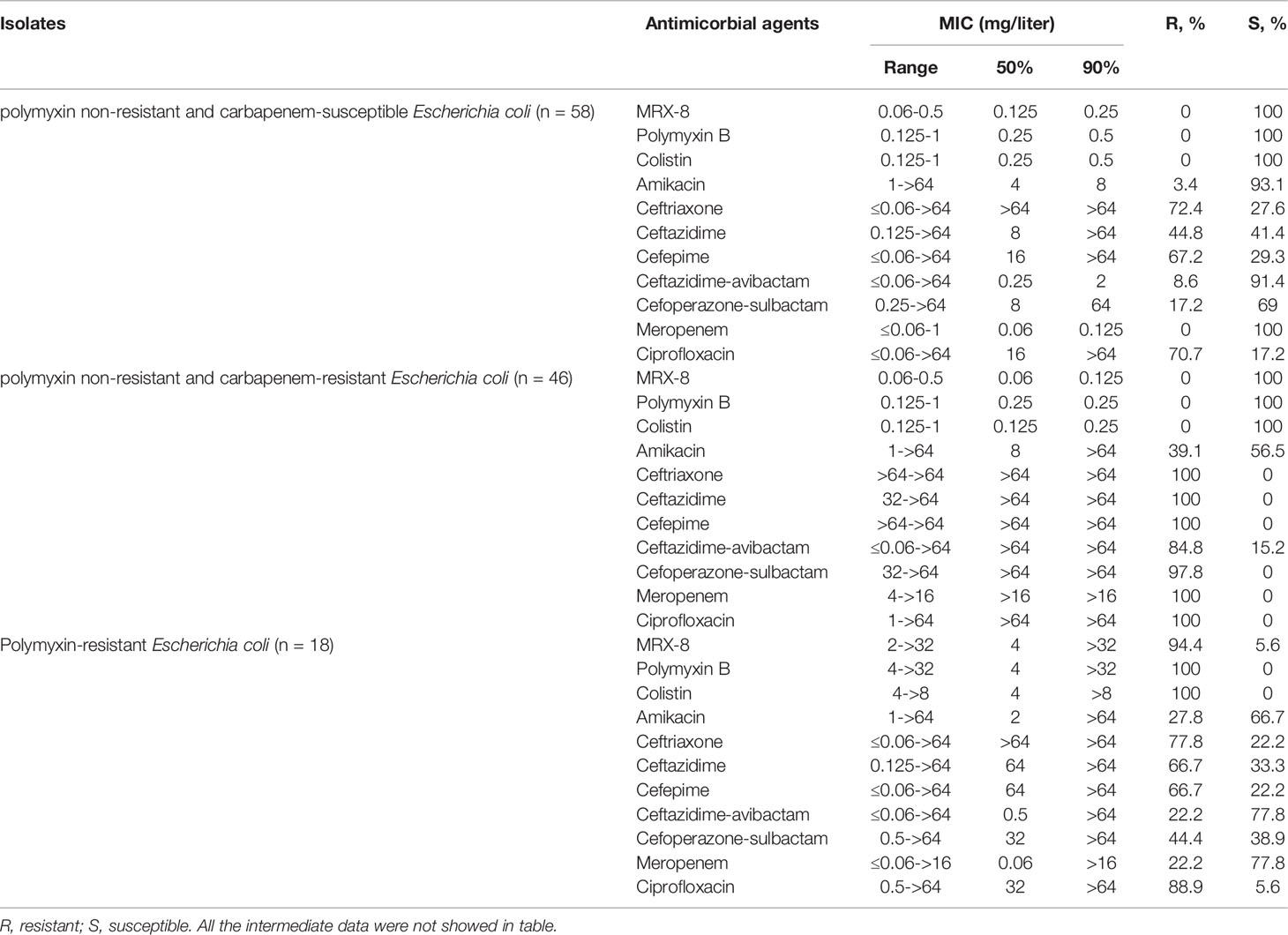
Table 1 In vitro activity of MRX-8 and other comparator agents against 122 of Escherichia coli (mg/L).
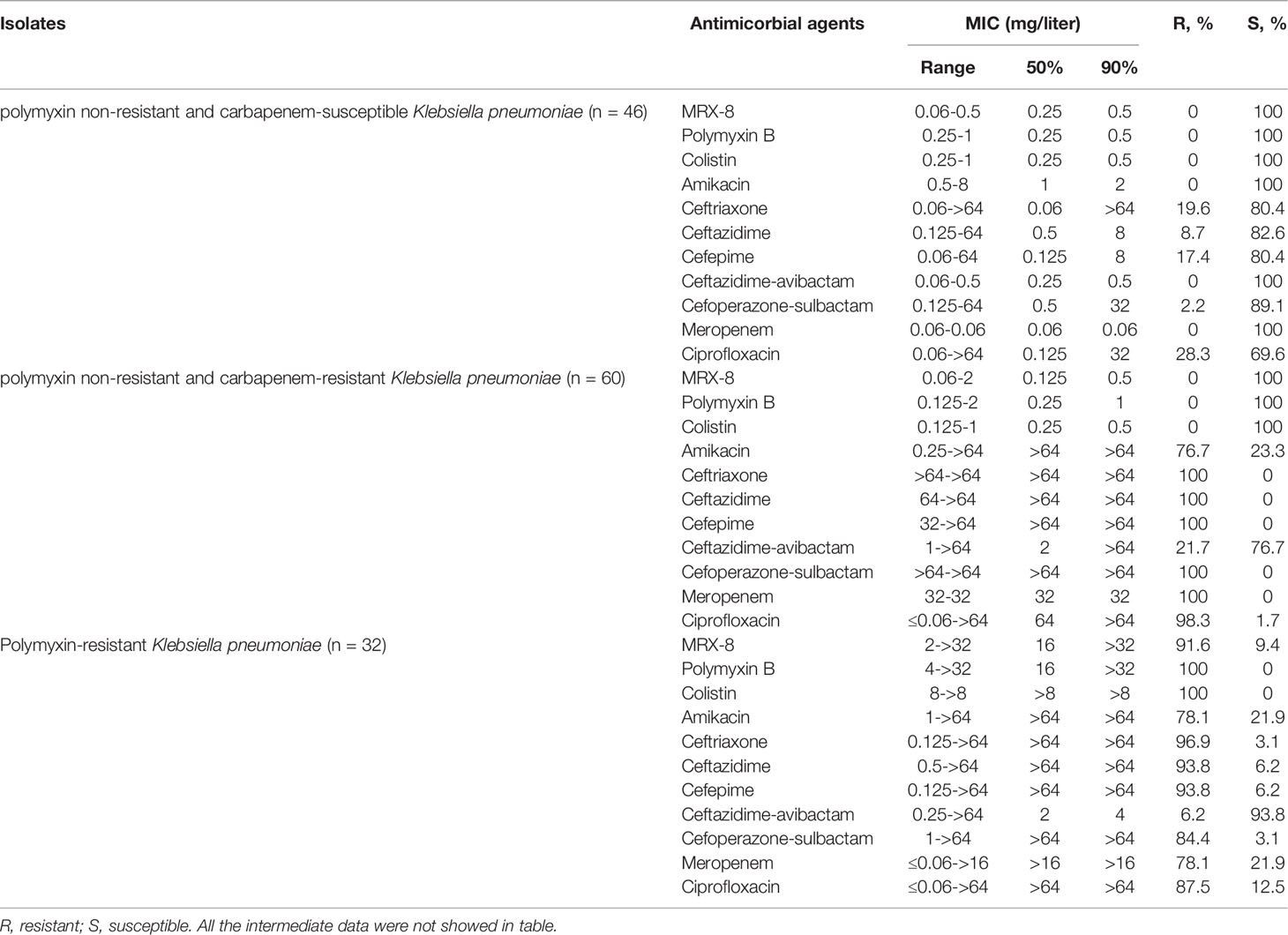
Table 2 In vitro activity of MRX-8 and other comparator agents against 138 of Klebsiella pneumoniae (mg/L).
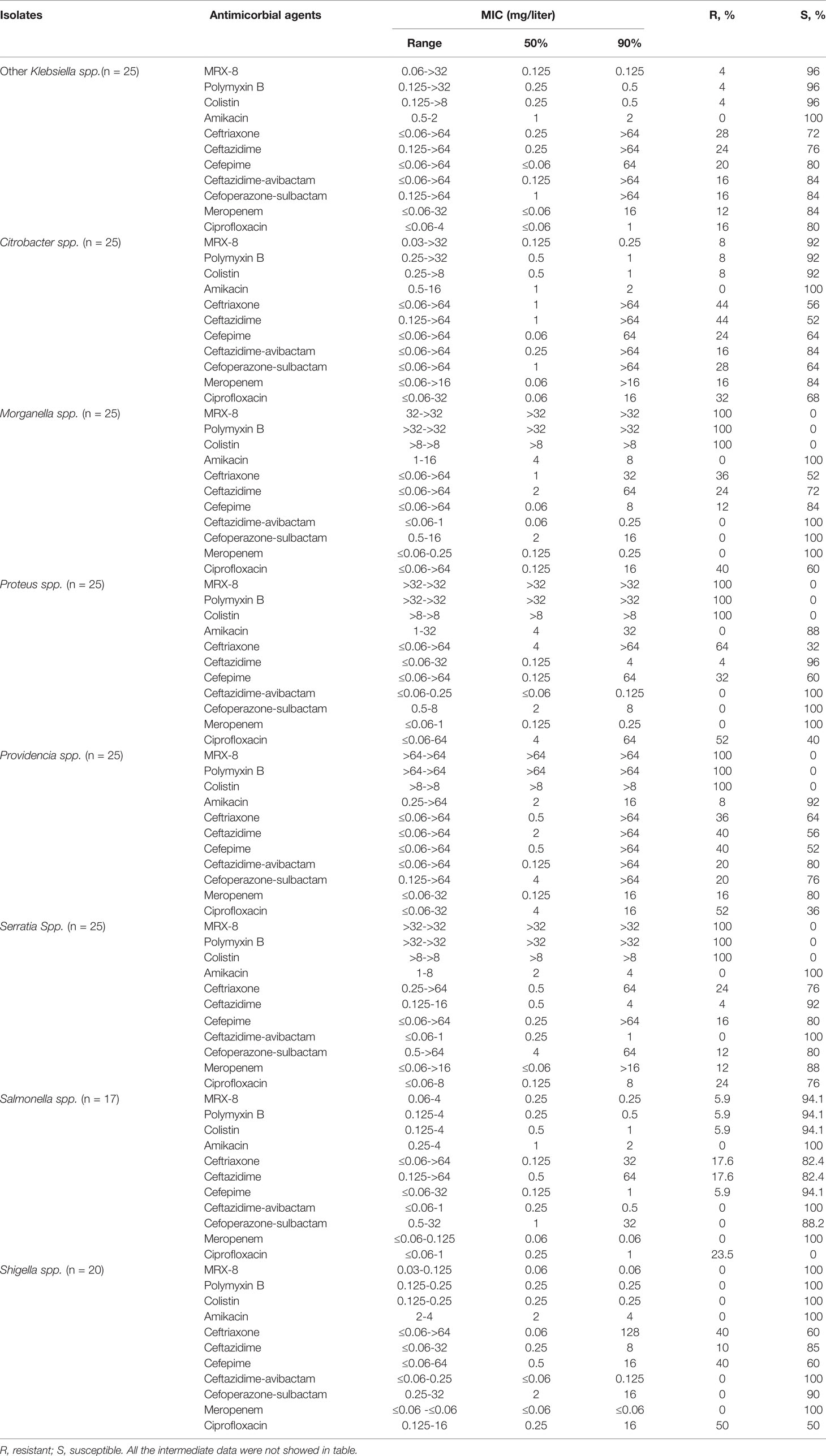
Table 3 In vitro activity of MRX-8 and other comparator agents against 187 of other Enterobacterales (mg/L).
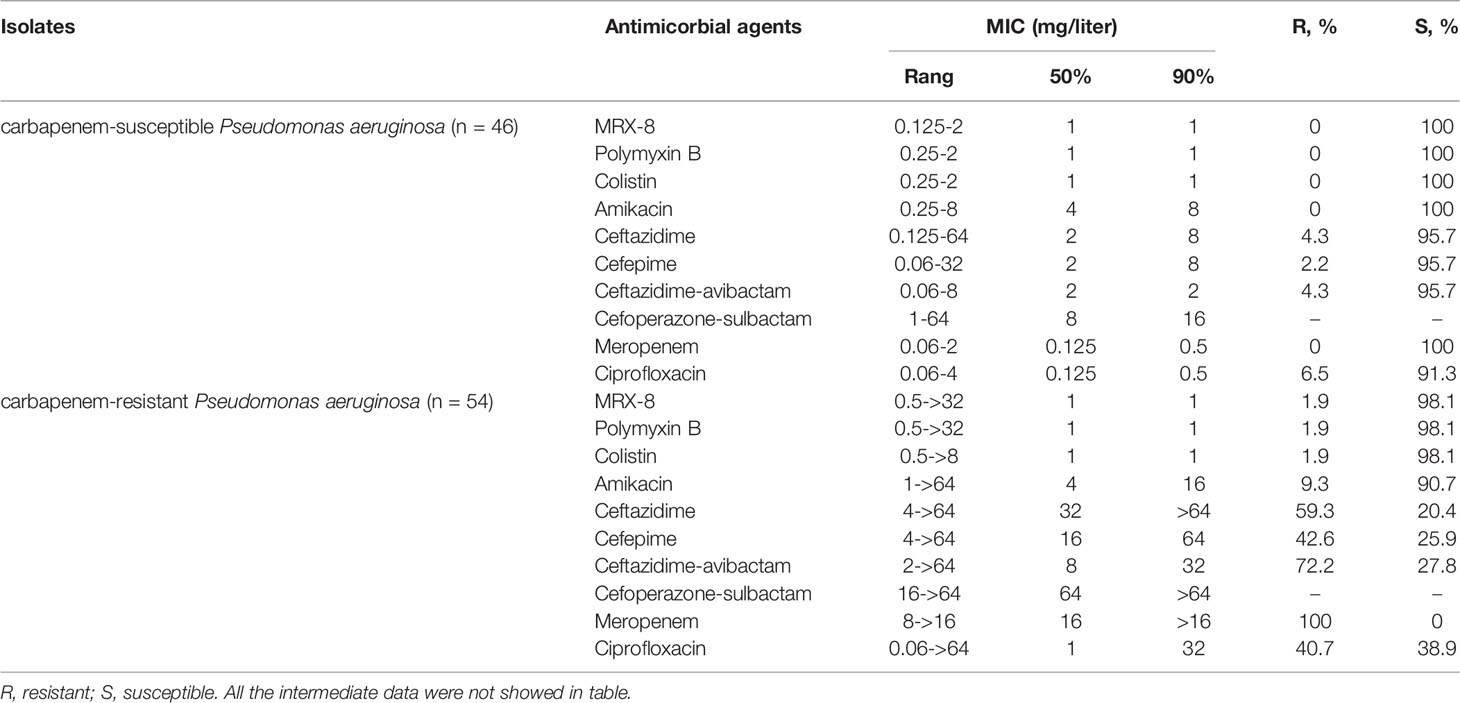
Table 4 In vitro activity of MRX-8 and other comparator agents against 100 of Pseudomonas aeruginosa (mg/L).
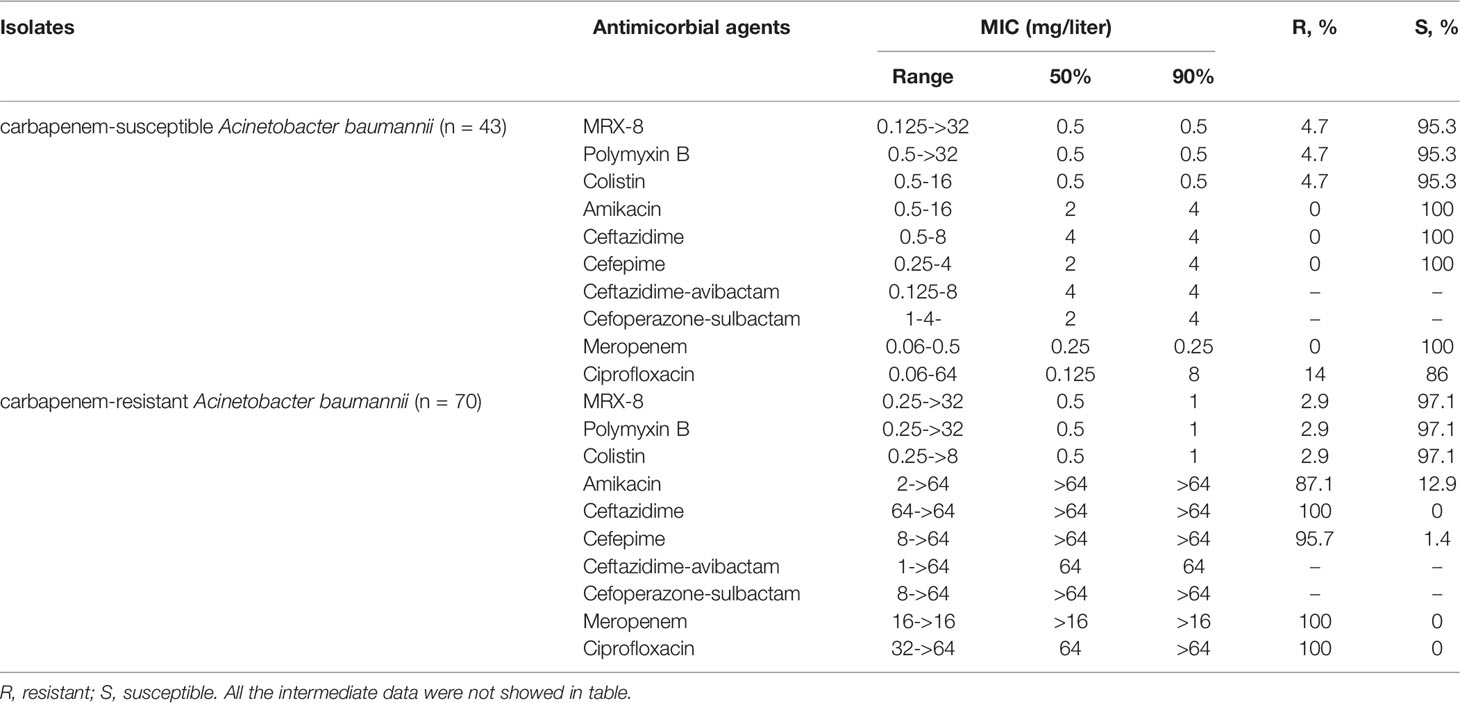
Table 5 In vitro activity of MRX-8 and other comparator agents against 113 of Acinetobacter baumannii (mg/L).
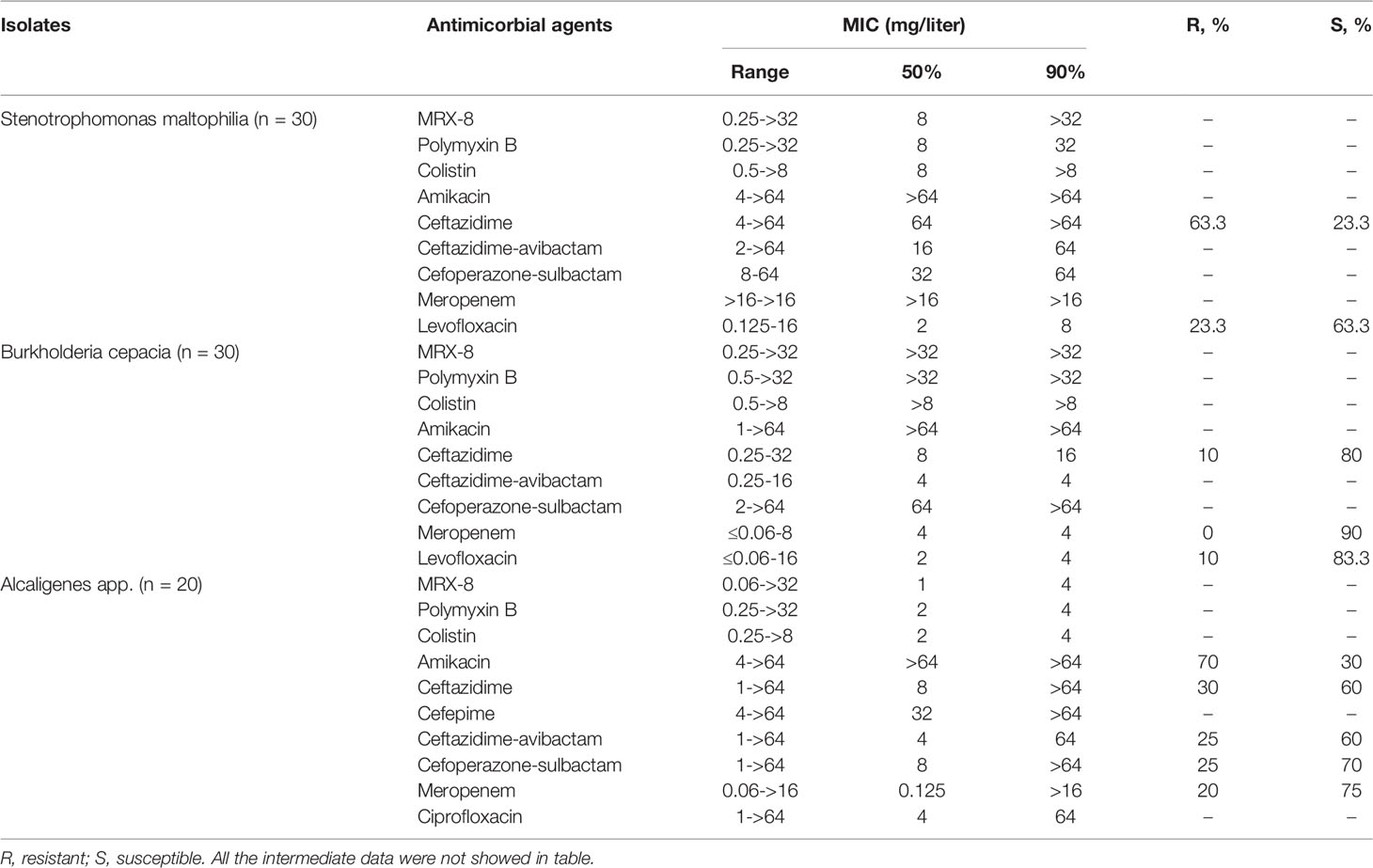
Table 6 In vitro activity of MRX-8 and other comparator agents against 80 of other non-fermentative bacteria (mg/L).

Table 7 In vitro activity of MRX-8 and other comparator agents against 25 of Haemophilus spp.(mg/L).
In Vitro Antimicrobial Activity Comparison With Comparators
For polymyxins-susceptible and carbapenem-resistant strains, the antibacterial activity of MRX-8 against E. coli and K. pneumoniae was in accordance with that of polymyxin B and colistin (100.0% susceptibility); and better than that of amikacin (56.5% and 23.3% susceptibility) and ceftazidime-avibactam (15.2% and 76.7% susceptibility); and significantly superior to other antibacterial agents (0-1.7% susceptibility). For polymyxins-susceptible and carbapenem-susceptible strains, the antibacterial activity of MRX-8 against E. coli and K. pneumoniae was in accordance with that of polymyxin B and colistin (100.0% susceptibility); and similar with amikacin (93.1% and 100% susceptibility) and ceftazidime-avibactam (91.4% and 100.0% susceptibility). For polymyxin-resistant strains, there’re still 5.6% of E. coli and 9.4% of K. pneumoniae isolates were susceptible to MRX-8 (Tables 1, 2).
As for other Enterobacterales, the antibacterial activity of MRX-8 against other Klebsiella spp. and Citrobacter spp. strains was little worse than that of amikacin (92.0-96.0% versus 100% susceptibility), and better than other antibacterial agents. For Morganella spp., Proteus spp., Providencia spp., and Serratia spp. strains, all were naturally resistant to MRX-8, polymyxin B and colistin, but most were susceptible to amikacin, ceftazidime-avibactam, cefoperazone-sulbactam, meropenem, and part of cephalosporins. For Salmonella enterica strains, the antibacterial activity of MRX-8 little worse than that of amikacin, ceftazidime/avibactam and meropenem (94.1% versus 100.0% susceptibility), and was similar to other antibacterial agents (82.4% to 94.1% susceptibility) except ciprofloxacin. For Shigella spp.strains, the antibacterial activity of MRX-8 was in accordance with that of amikacin, ceftazidime/avibactam and meropenem (100.0% susceptibility), and was superior to other antibacterial agents (50.0%-90.0% susceptibility) (Table 3).
For carbapenem-susceptible P. aeruginosa and A. baumannii, MRX-8 showed similar in vitro antibacterial activity with polymyxin B, colistin, amikacin, ceftazidime and cefepime (100.0% versus 95.7-100.0% susceptibility; 95.3% versus 95.3-100.0% susceptibility). However, for carbapenem-resistant P. aeruginosa and A. baumannii, it was significantly superior to comparators except polymyxins (Tables 4, 5). The antibacterial activity of MRX-8 against S. maltophilia was worse than levofloxacin, and similarly poor to polymyxin B, colistin and other antibacterial agents. The antibacterial activity of MRX-8 against B. cepacia was inferior to that of ceftazidime, ceftazidime-avibactam, meropenem and levofloxacin, and similar to that of others. The antibacterial activity of MRX-8 against Alcaligenes app. was similar to that of polymyxin B and colistin, and better than other antibacterial agents (Table 6). The antibacterial activity of MRX-8 and polymyxin B against Haemophilus spp. was similarly strong to that of ampicillin and ampicillin-sulbactam, but little worse than ceftriaxone and levofloxacin (96.0% and 92.0% susceptibility) (Table 7).
Disscussion
At present, the clinical use of polymyxins antibiotics in China are mainly two elements, polymyxin B and colistin. Polymyxins play an antibacterial role mainly by interacting with lipopolysaccharides (LPS) lipid A component of bacterial cell membrane to increase the permeability of bacterial outer membrane (Vaara, 1992). Therefore, one of the main mechanisms of bacterial resistance to polymyxins is the modification of LPS in outer membrane. Plasmid-mediated colistin resistance gene mcr-1 was first discovered in E. coli origined from animals in 2015, and this gene could transmit between different species through plasmids, mediating low levels of colistin resistance (Liu et al., 2016). Currently, mcr-1 to mcr-9 subtypes of mcr genes has been reported worldwide, and the most common one in China is mcr-1, followed by mcr-3 and mcr-8, which are mainly distributed in Enterobacterales with low detection rates (0.52% to 1.62%) (Shi et al., 2020). In 2018, Results from the China antimicrobial resistance surveillance network (CHINET) of 2018 showed that 87.9% and 93.8% of the carbapenem-resistant E. coli and K. pneumoniae were susceptible to polymyxin B, suggesting that polymyxin B still has high antibacterial activity against the multi-drug-resistant strains, especially carbapenem-resistant strains (Yang et al., 2020). As one of the optional “last line of defense” antibiotics, polymyxins are often clinically used to treat the infection of multidrug-resistant gram-negative bacteria.
MRX-8 is a new generation of polymyxins, containing a fatty acyl tail attached via an ester bond, which allows for deesterification to a less toxic metabolite (Duncan, 2022). After modification, not only the antibacterial activity is enhanced, but also the renal toxicity is significantly reduced compared to polymyxin B (Duncan, 2022). Seen from this study, the MICs of polymyxin B and colistin was 2-4 times higher than that of MRX-8 when against E. coli, Citrobacter spp. and Shigella spp., and was 1-2 times higher when against Alcaligenes app., K. pneumoniae and Haemophilus spp., and the same as that of MRX-8 when against P. aeruginosa or A. baumannii, indicating that the antibacterial activity of MRX-8 against most tested bacteria was slightly better than or similar to that of polymyxin B and colistin. We also found that when strains were resistant to polymyxin B or colistin, most of them were also resistant to MRX-8 (94.4% of E. coli and 91.6% of K. pneumoniae), so we could speculate that in vitro activity of MRX-8 is little excellent than polymyxin B or colistin. Considering the markedly reduced nephrotoxicity of MRX-8 over PMB has been confirmed in vivo, MRX-8 is potential for improved efficacy against certain Gram-infections (Duncan, 2022).
For CR-PAE, MRX-8, polymyxin B, colistin and amikacin all showed excellent antibacterial activity, which was far better than that of ceftazidime-avibactam. For CR-ABA, except MRX-8, polymyxin B and colistin showed good antibacterial activity, the other drugs all showed poor antibacterial activity. Currently, there are few in vitro pharmacodynamics studies of MRX-8 either at home and abroad. Lepak AJ et al. compared the in vivo antimicrobial activity of MRX-8 and colistin using the thigh and lung infection models of granulocytopenia mice, showing that MRX-8 and colistin had good in vivo antibacterial activity against E. coli, K. pneumoniae, P. aeruginosa and A. baumannii, and the activity increased with the increase of dose (Lepak et al., 2020).
One of the limitation of this study is the number of strains of each bacteria is small. In the future, continuous in vitro antibacterial activity studies are needed to monitor the resistant change of bacteria to MRX-8.
Conclusion
MRX-8 was more effective against most clinically isolated Enterobacteriaceae, including carbapenem-resistant E. coli and K. pneumoniae, highlighting its potential as valuable therapeutics.
Data Availability Statement
The raw data supporting the conclusions of this article will be made available by the authors, without undue reservation.
Ethics Statement
This study was granted exemption from requiring ethics approval, because none of animals or human samples were involved in this study and no potentially identifiable human images or data was presented in this manuscript.
Author Contributions
All authors contributed to the experiment operation and data collection in this study. FH contributed to the study conception and design. Material preparation and analysis were mainly performed by SW and PZ. The first draft of the manuscript was written by DY and FH revised on previous versions of the manuscript. All authors read and approved the final manuscript.
Funding
This work was funded by the National Key Research and Development Program of China (2021YFC2701803), the China Antimicrobial Surveillance Network (Independent Medical Grants from Pfizer, 2018QD100), Shanghai MicuRx Pharmaceutical Co. Ltd and Shanghai Antimicrobial. Surveillance Network (3030231003). The funders had no role in study design, data collection and analysis, decision to publish or preparation of the manuscript.
Conflict of Interest
The authors declare that the research was conducted in the absence of any commercial or financial relationships that could be construed as a potential conflict of interest.
Publisher’s Note
All claims expressed in this article are solely those of the authors and do not necessarily represent those of their affiliated organizations, or those of the publisher, the editors and the reviewers. Any product that may be evaluated in this article, or claim that may be made by its manufacturer, is not guaranteed or endorsed by the publisher.
References
Bergen, P. J., Landersdorfer, C. B., Lee, H. J., Li, J, Nation, R. L. (2012). 'Old' Antibiotics for Emerging Multidrug-Resistant Bacteria. Curr. Opin. Infect. Dis. 25, 626–633. doi: 10.1097/QCO.0b013e328358afe5
Brown, P., Dawson, M. J. (2017). Development of New Polymyxin Derivatives for Multi-Drug Resistant Gram-Negative Infections. J. Antibiot (Tokyo) 70, 386–394. doi: 10.1038/ja.2016.146
Duncan, L. R., Wang, W., Sader, H. S. (2022). In Vitro Potency and Spectrum of the Novel Polymyxin MRX-8 Tested against Clinical Isolates of Gram-Negative Bacteria. Antimicrob Agents Chemother. Antimicrob Agents Chemother. e0013922. doi: 10.1128/aac.00139-22
Lepak, A. J., Wang, W., Andes, D. R. (2020). Pharmacodynamic Evaluation of MRX-8, a Novel Polymyxin, in the Neutropenic Mouse Thigh and Lung Infection Models Against Gram-Negative Pathogens. Antimicrob. Agents Chemother. 64, e01517-20. doi: 10.1128/AAC.01517-20
Liu, Y. Y., Wang, Y., Walsh, T. R., Yi, L. X., Zhang, R., Spencer, J., et al. (2016). Emergence of Plasmid-Mediated Colistin Resistance Mechanism MCR-1 in Animals and Human Beings in China: A Microbiological and Molecular Biological Study. Lancet Infect. Dis. 16, 161–168. doi: 10.1016/S1473-3099(15)00424-7
Nang, S. C., Azad, M. A. K., Velkov, T., Zhou, Q. T., Li, J. (2021). Rescuing the Last-Line Polymyxins: Achievements and Challenges. Pharmacol. Rev. 73, 679–728. doi: 10.1124/pharmrev.120.000020
Shi, X. M., Li, Y. M., Yang, Y. Y., Shen, Z. Q., Wu, Y. N., Wang, S. L., et al. (2020). Global Impact of Mcr-1-Positive Enterobacteriaceae Bacteria on "One Health". Crit. Rev. Microbiol. 46, 565–577. doi: 10.1080/1040841X.2020.1812510
Tsuji, B. T., Pogue, J. M., Zavascki, A. P., Paul, M., Daikos, G. L., Forrest, A., et al. (2019). International Consensus Guidelines for the Optimal Use of the Polymyxins: Endorsed by the American College of Clinical Pharmacy (ACCP), European Society of Clinical Microbiology and Infectious Diseases (ESCMID), Infectious Diseases Society of America (IDSA), International Society for Anti-Infective Pharmacology (ISAP), Society of Critical Care Medicine (SCCM), and Society of Infectious Diseases Pharmacists (SIDP). Pharmacotherapy 39, 10–39. doi: 10.1002/phar.2209
Vaara, M. (1992). Agents That Increase the Permeability of the Outer Membrane. Microbiol. Rev. 56, 395–411. doi: 10.1128/mr.56.3.395-411
Vaara, M. (2019). Polymyxins and Their Potential Next Generation as Therapeutic Antibiotics. Front. Microbiol. 10. doi: 10.3389/fmicb.2019.01689
Wayne, P. (2021). Performance Standards for Antimicrobial Susceptibility Testing. 31st ed. CLSI supplement M100. (USA: Clinical and Laboratory Standards Institute).
Yang, Y., Guo, Y., Yin, D., Zheng, Y. G., Wu, S., Zhu, D. M., et al. (2020). In Vitro Activity of Cefepime-Zidebactam, Ceftazidime-Avibactam, and Other Comparators Against Clinical Isolates of Enterobacterales, Pseudomonas Aeruginosa, and Acinetobacter Baumannii: Results From China Antimicrobial Surveillance Network (CHINET) in 2018. Antimicrob. Agents Chemother. 65, e01726-20. doi: 10.1128/AAC.01726-20
Keywords: MRX-8, minimal inhibitory concentration, colistin, polymyxin B, gram-negative bacteria
Citation: Wu S, Yin D, Zhi P, Guo Y, Yang Y, Zhu D and Hu F (2022) In Vitro Activity of MRX-8 and Comparators Against Clinical Isolated Gram-Negative Bacilli in China. Front. Cell. Infect. Microbiol. 12:829592. doi: 10.3389/fcimb.2022.829592
Received: 06 December 2021; Accepted: 20 April 2022;
Published: 12 May 2022.
Edited by:
Milena Dropa, University of São Paulo, BrazilReviewed by:
Roger M. Echols, Infectious Disease Drug Development Consulting, LLC, United StatesRafael Vignoli, Universidad de la República, Uruguay
Copyright © 2022 Wu, Yin, Zhi, Guo, Yang, Zhu and Hu. This is an open-access article distributed under the terms of the Creative Commons Attribution License (CC BY). The use, distribution or reproduction in other forums is permitted, provided the original author(s) and the copyright owner(s) are credited and that the original publication in this journal is cited, in accordance with accepted academic practice. No use, distribution or reproduction is permitted which does not comply with these terms.
*Correspondence: Fupin Hu, aHVmdXBpbkBmdWRhbi5lZHUuY24=
†These authors have contributed equally to this work
 Shi Wu
Shi Wu Dandan Yin
Dandan Yin Peiyuan Zhi1,2
Peiyuan Zhi1,2 Fupin Hu
Fupin Hu